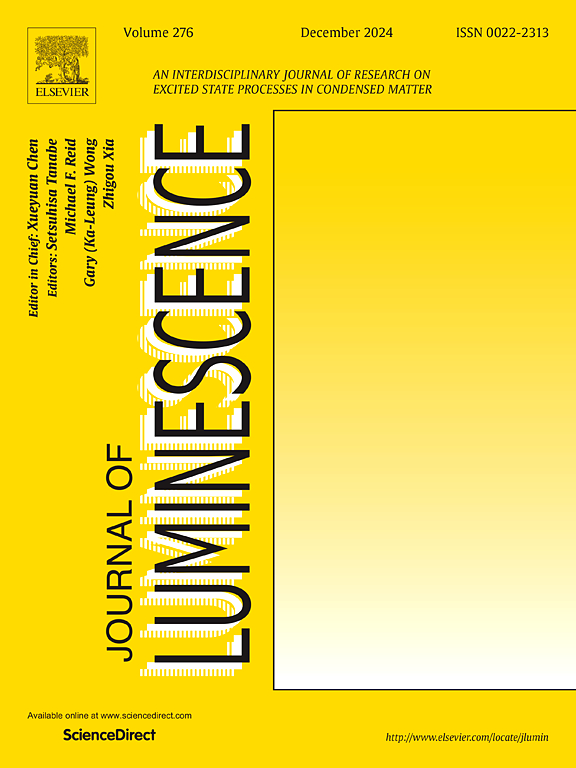Near-unity quantum efficiency and remarkable anti-thermal quenching of Cr3+-activated Gd3AlGa4O12 garnet emitter for advanced broadband NIR light source
IF 3.3
3区 物理与天体物理
Q2 OPTICS
引用次数: 0
Abstract
Advances in broadband near-infrared (NIR) emitting materials represent a pivotal frontier for next-generation intelligent NIR phosphor-converted light-emitting diode (pc-LED) technologies. However, practical implementation of these materials has been constrained by challenges such as suboptimal quantum efficiency (QE) and pronounced thermal quenching (TQ). In this study, we report the synthesis and comprehensive characterization of broadband NIR-emitting phosphors, Gd3AlGa4O12:Cr3+, exhibiting anti-TQ properties without compromising QE. The material's inherent structural rigidity, wide bandgap, and the minimal electron-phonon coupling (EPC) effect provide a foundation for high-performance broadband NIR luminescence. Strategic optimization of Cr3+ doping concentrations, combined with controlled excited-state electron migration, achieves an internal quantum efficiency (IQE) of 98.23 % and a remarkable anti-TQ capability (135.1 %@483 K). The practical potential is further demonstrated through prototype NIR pc-LED implementation, where integration with a commercial blue LED chip delivers an NIR output power of 285.38 mW at 1170 mA and a wall-plug efficiency (WPE) of 17.42 % at 30 mA, highlighting its potential for use in diverse applications such as plant growth, component analysis, night vision, nondestructive detection, and non-invasive imaging. Overall, this work addresses critical challenges in broadband NIR phosphors and advances the development of high-performance and energy-efficient miniatured broadband NIR light sources.

先进宽带近红外光源用Cr3+活化Gd3AlGa4O12石榴石发射体的近单位量子效率和显著的抗热猝灭性能
宽带近红外(NIR)发射材料的进展是下一代智能近红外磷转换发光二极管(pc-LED)技术的关键前沿。然而,这些材料的实际实施受到诸如次优量子效率(QE)和明显的热猝灭(TQ)等挑战的限制。在这项研究中,我们报道了宽带nir发光荧光粉Gd3AlGa4O12:Cr3+的合成和综合表征,该荧光粉具有抗tq性能而不影响QE。该材料固有的结构刚性、宽带隙和最小的电子-声子耦合(EPC)效应为高性能宽带近红外发光提供了基础。策略优化Cr3+掺杂浓度,结合受控激发态电子迁移,实现了98.23%的内量子效率(IQE)和135.1%的抗tq能力(@483 K)。通过原型近红外pc-LED实现进一步展示了实际潜力,其中与商用蓝色LED芯片集成,在1170 mA时提供285.38 mW的近红外输出功率,在30 mA时提供17.42%的壁插效率(WPE),突出了其在多种应用中的潜力,如植物生长,成分分析,夜视,无损检测和非侵入性成像。总的来说,这项工作解决了宽带近红外荧光粉的关键挑战,并推进了高性能和节能的微型宽带近红外光源的发展。
本文章由计算机程序翻译,如有差异,请以英文原文为准。
求助全文
约1分钟内获得全文
求助全文
来源期刊

Journal of Luminescence
物理-光学
CiteScore
6.70
自引率
13.90%
发文量
850
审稿时长
3.8 months
期刊介绍:
The purpose of the Journal of Luminescence is to provide a means of communication between scientists in different disciplines who share a common interest in the electronic excited states of molecular, ionic and covalent systems, whether crystalline, amorphous, or liquid.
We invite original papers and reviews on such subjects as: exciton and polariton dynamics, dynamics of localized excited states, energy and charge transport in ordered and disordered systems, radiative and non-radiative recombination, relaxation processes, vibronic interactions in electronic excited states, photochemistry in condensed systems, excited state resonance, double resonance, spin dynamics, selective excitation spectroscopy, hole burning, coherent processes in excited states, (e.g. coherent optical transients, photon echoes, transient gratings), multiphoton processes, optical bistability, photochromism, and new techniques for the study of excited states. This list is not intended to be exhaustive. Papers in the traditional areas of optical spectroscopy (absorption, MCD, luminescence, Raman scattering) are welcome. Papers on applications (phosphors, scintillators, electro- and cathodo-luminescence, radiography, bioimaging, solar energy, energy conversion, etc.) are also welcome if they present results of scientific, rather than only technological interest. However, papers containing purely theoretical results, not related to phenomena in the excited states, as well as papers using luminescence spectroscopy to perform routine analytical chemistry or biochemistry procedures, are outside the scope of the journal. Some exceptions will be possible at the discretion of the editors.
 求助内容:
求助内容: 应助结果提醒方式:
应助结果提醒方式:


